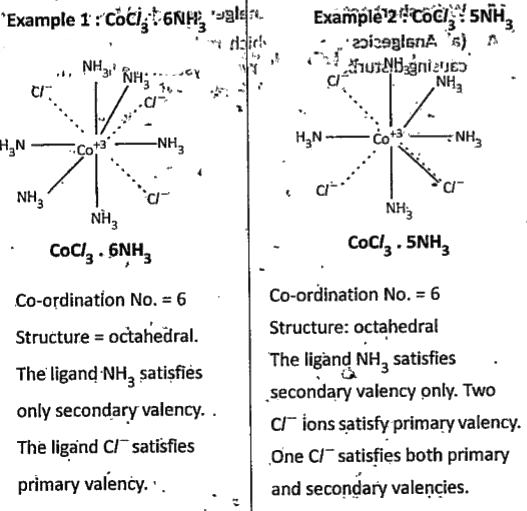Explain ionic bond with suitable example.Solution in Telugu
1) Every complex comp i contains a central atom (or) ion.
2) The central metal atom (or) ion exhibits two types of valencies. They are a) Primary valency b) Secondary valency.
a) The Primary valency: It is numerically equal to the oxidation number of the metal atom or ion. These valencies. are ionisable. These valencies are represented by dotted line (. . . . . . )These valencies are non- directional.
b) Secondary valency: The number of chemical groups bound to the central atom (or) ion is equal to secondary valency. This is also called co-ordination number. These ies are directional and non-ionisable. These are represented by thick line(________)
3) Some ligands may. satisfy both primary and secondary valencies. Such ligands do not onise.
4) The primary valency, is known, as outer, sphere while the secondary valency is known as inner sphere for.co-ordination sphere

Topper's Solved these Questions
- BOOK - VGS PUBLICATION-BRILLIANTCHAPTER - MODEL PAPER EXERCISE - Section - C8videos
MODEL PAPER
- BOOK - VGS PUBLICATION-BRILLIANTCHAPTER - MODEL PAPER EXERCISE - Section - C8videos
MODEL PAPER
- BOOK - VGS PUBLICATION-BRILLIANTCHAPTER - HYDROGEN AND ITS COMPOUNDS EXERCISE - Long Answer Questions20videos
HYDROGEN AND ITS COMPOUNDS
- BOOK - VGS PUBLICATION-BRILLIANTCHAPTER - MODEL PAPER 1 EXERCISE - SECTION-C9videos
MODEL PAPER 1
Similar Questions
State and explain Kohlrausch's law of indendent migration of ions.
04:38View SolutionState and explain Kohlrausch's law of indendent migration of ions.
02:52View SolutionWrite an essay on the commericial preparation of dihydrogen. Give balanced equations.
01:36View SolutionState and explain Kohlrausch's law of indendent migration of ions.
04:04View SolutionExplain with the help of suitable example polar covalent bond.
02:31View SolutionWhat is an ionic bond ? With two suitable examples, explain the diference between an ionic and a covalent bond ?
View SolutionExplain the formation of ionic bond with two examples.
02:13View SolutionExplain with the help of suitable example polar covalent bond.
02:19View SolutionExplain the following with suitable examples :
Ionic hydrides02:02View SolutionDefine ionic bond. Give suitable examples and distinguish between covalent bond and ionic bond.
04:11View SolutionExplain Polar Covalent bond with a suitable example.
View SolutionExplain the formation of Ionic Bond with a suitable example.
05:47View SolutionExplain Non-ionic detergents with suitable examples ?
02:17View Solution(i) What is an ionic bond? (ii) Explain about the formation of ionic bond with a suitable example.
02:01View SolutionWhal is an ionic bond ? With two suitable examples explain the difference between an ionic and a covaJent bond ?
02:08View SolutionExplain with the help of suitable example polar covalent bond.
05:58View Solution

